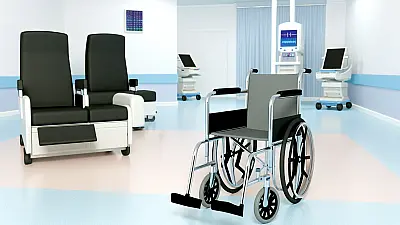SAINT IGNACE, MI - State health inspectors documented critical safety violations at Mackinac Straits Long Term Care Unit involving the improper use of bed rails for a resident with severe dementia, revealing systemic failures in safety protocols and informed consent procedures during a May 2025 inspection.

Bed Rail Safety Violations Exposed Critical Gaps
The facility's failure to properly assess and document bed rail safety for Resident #46, an individual with severe vascular dementia, represents a significant departure from federal safety standards. Inspectors observed the resident with bed rails installed on both sides of the bed on May 27, 2025, yet discovered no documentation of essential safety evaluations or medical justification for their use.
The resident, who had been admitted with severe vascular dementia, scored 99 on the Brief Interview for Mental Status (BIMS) assessment - a score indicating the individual was unable to complete the cognitive test due to severely impaired mental function. This level of cognitive impairment makes the resident particularly vulnerable to entrapment risks associated with bed rails.
Despite the resident's documented dependence on staff for all activities of daily living, including bed mobility, turning, and repositioning, the facility had not conducted an entrapment risk assessment before installing the bed rails. This fundamental safety evaluation determines whether gaps between the rail and mattress could pose strangulation or suffocation hazards - risks that are especially serious for residents who cannot reposition themselves independently.
Missing Physician Orders and Medical Documentation
Federal regulations require specific physician orders for bed rail use, including clear medical rationale and circumstances justifying their installation. However, inspectors found no such order in Resident #46's medical records. This absence of medical authorization represents a serious breach of protocol that bypasses the clinical oversight necessary to ensure resident safety.
The facility's own Side Rail Assessment form, dated January 14, 2025, explicitly stated that "a written order from the resident's attending Physician, specifying the medical rationale and circumstances for use, must be obtained prior to the installation of this medical treatment device." Despite this clear requirement in their own documentation, no physician order existed.
When asked to provide the medical reason for bed rail use on the assessment form, staff had written only "When in bed" - a response that fails to identify any specific medical symptoms or clinical indications. The section designated for "Specific medical symptoms which require side rail use" was left completely blank, demonstrating a fundamental misunderstanding of regulatory requirements.
Informed Consent Process Compromised
The informed consent process for bed rail use was severely compromised by the facility's inadequate documentation. While the resident's representative had signed a consent form on January 14, 2025, this signature was obtained without proper disclosure of risks and benefits associated with bed rail use.
Bed rails carry documented risks including entrapment between the rail and mattress, falls when attempting to climb over rails, skin breakdown from contact with rails, and increased agitation in residents with dementia who may feel trapped. Benefits might include prevention of rolling out of bed or assistance with repositioning. None of these critical factors were documented or discussed with the resident's representative.
For residents with severe cognitive impairment like Resident #46, who cannot advocate for themselves or communicate discomfort, the informed consent process becomes even more crucial. The representative must have complete information to make decisions in the resident's best interest. The facility's failure to document this risk-benefit discussion means the representative's consent was not truly informed.
Failure to Attempt Alternative Interventions
Federal regulations mandate that facilities must attempt less restrictive alternatives before implementing bed rails. These alternatives include lowered bed heights, floor mats beside the bed, increased monitoring, positioning devices, or specialized low beds that reduce fall injury risk without creating entrapment hazards.
No documentation existed showing that any alternatives were attempted or even considered for Resident #46. This represents a violation of the fundamental principle of using the least restrictive intervention necessary to ensure resident safety. For a resident completely dependent on staff assistance, alternatives such as a low bed positioned close to the floor could provide fall protection without the entrapment risks associated with bed rails.
Critical Measurements Never Taken
The facility failed to document bed dimensions and measurements to ensure appropriateness for the resident's size and weight. Proper bed rail installation requires specific measurements to ensure gaps between the rail and mattress don't exceed safe limits. The Entrapment Risk Assessment protocol requires measuring seven specific zones where body parts could become trapped, including the space between the rail and mattress, between rail sections, and between the headboard and rail.
Without these measurements, the facility cannot verify that the bed rails meet safety standards established to prevent entrapment injuries and deaths. This is particularly concerning given that Resident #46 was documented as being unable to reposition independently, meaning any entrapment situation could quickly become life-threatening.
Additional Issues Identified
Beyond the primary bed rail violations, inspectors noted the facility's failure to maintain periodic review and re-evaluation procedures for bed rail necessity as promised in their own assessment forms. The facility's Side Rail Assessment explicitly stated they would "periodically review and re-evaluate the resident's need for bed rails," yet no such reviews were documented in the medical record.
The inspection findings represent violations of federal regulation F-tag 700, which governs bed rail use in skilled nursing facilities. These regulations exist because improper bed rail use has been linked to serious injuries and deaths in nursing home settings, particularly among residents with cognitive impairment who may not understand the danger or be able to call for help if entrapped.
The complete inspection report contains additional details about the facility's corrective action requirements and timeline for addressing these deficiencies.
Full Inspection Report
The details above represent a summary of key findings. View the complete inspection report for Mackinac Straits Long Term Care Unit from 2025-05-29 including all violations, facility responses, and corrective action plans.
💬 Join the Discussion
Comments are moderated. Please keep discussions respectful and relevant to nursing home care quality.